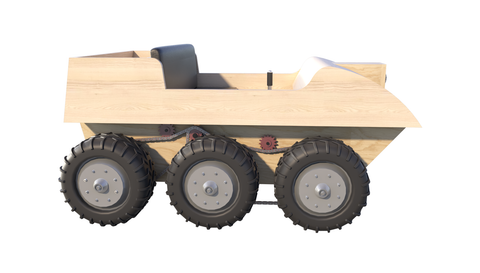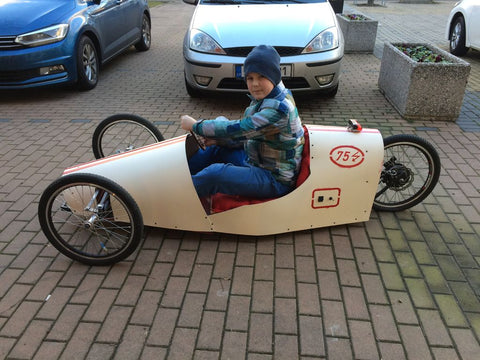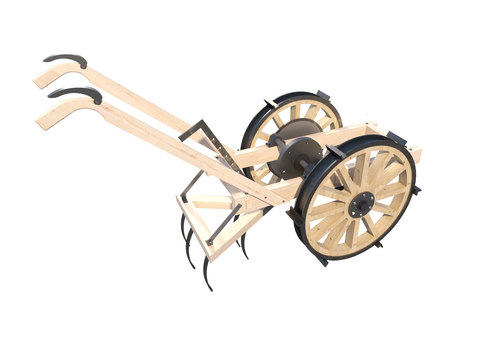Golf Cart Build Free DIY Plans 2 Passenger Seat 3 Wheel Utility Vehicle
These free DIY plans will show you how to complete your Golf Cart Build.
First, it's a golf cart powerful enough to carry two adults and equipment up steep slopes. But it's also a heart-saver for the aged, "legs" for an invalid, and a "school bus" or shopping "car" for Mom. It features twin-motor drive, four speeds forward and reverse, coil-spring suspension, -wheel brakes and tricycle steering, plus a built-in battery charger
SPEEDS UP TO 20 m.p.h. and 30 to 40 miles on a single charging of the batteries make this cart an ideal utility vehicle for any home, farm or business. The cart is wide and low, both to assure stability on any terrain and to provide ample room for any of several combinations of motors and batteries.
What is a Golf Cart?
A golf cart is a small motor vehicle used for transporting golf clubs and golfers. It is also known as a golf trolley or golf car. Although the name is now redirected to the compact passenger car Volkswagen Golf, the golf cart was first designed to carry two golfers and their clubs around a golf course or desert trail.
Components of a golf cart
The golf cart's electrical system is comprised of several components. The solenoid, for example, is responsible for allowing electricity to flow from the batteries to the motor. It makes a clicking noise when it's in the "on" position, and engages every time you step on the brake or accelerator. Occasionally, the solenoid can fail or need replacement. To diagnose the problem, check the wiring and components.
The battery is an essential part of a golf cart. It powers the motor and allows the cart to move around the course. It should be cleaned regularly to keep it free of corrosion, and the battery fluid should be filled properly. It also needs to be recharged regularly. The electrical system also includes the motor, wires, and circuitry. All of these components require regular maintenance.
Gasoline-powered vs. electric
There are some key differences between gasoline-powered and electric golf carts. Gasoline golf carts use an internal combustion engine, which is noisy. The electric version emits a whirring sound instead. Electric golf carts are more environmentally friendly than gas-powered ones.
Gasoline-powered golf carts require fewer routine maintenance tasks than their electric counterparts. However, they do require annual service, oil changes, and filters. Gas golf carts also have a longer range than electric golf carts. Gas carts can go up to 200 miles on a tank. Electric golf carts require access to electrical outlets to run.
Gas-powered carts tend to have more power. But they are not always faster. Electric carts tend to be quieter than their gas counterparts, so they are great for green spaces. However, they have some disadvantages, like not being able to meet speed requirements for surface roads.
Regulations for driving a golf cart on the street
Before you can drive your golf cart on the street, it is important to know the rules in your area. Your local and state governments will have specific regulations about golf carts on public roads. It is important to follow these laws or face legal penalties. If you violate these rules, you could be fined or even arrested.
First, you need to know that golf carts are considered low-speed vehicles. You can drive them on streets and highways, but only if the town you live in permits it. You will need to drive slowly and display a safety flag. Also, you cannot exceed thirty miles per hour.
Cost of a golf cart
When you buy a golf cart, there are a few things to keep in mind. Some models cost more than others, and others are cheaper to purchase and operate than others. You should also consider the warranty for your cart. A basic warranty usually lasts around five years, and a better one may last up to ten years.
Another factor that impacts the cost of your golf cart is reconditioning. Many private owners and golf cart lots invest a lot of time and money in improving the cart. This can push up the cost. This can include washing, touching up scratches, adding new paint, upgrading brakes, installing new tires, installing new cables and batteries, and changing the oil.
Buying a golf cart
Buying a golf cart can be a difficult and time-consuming process. To get a great cart, you need to know your needs and your budget before you buy. The following tips will help you make an informed decision and get the best cart for your needs. The first step is to ask questions and do your research. Then, you can narrow down your choices and make an informed decision.
The next step is to make sure that the cart you're considering is in good condition. Make sure the tires are in good shape and that the wheels are balanced. Also, take the time to test drive the cart to ensure it won't have any problems.
All DIY plans are designed by Ben Stone. Ben is a retired Engineer in Canada. Ben also drafts these himself using the latest AutoCAD software to ensure accuracy. He studied Engineering back in the early 1980's. After over 30 years in the Construction industry he developed a passion for building cool items around his farm and cabin. These are great DIY projects. With a little skill anybody can Do It Yourself. Ben is always a email away if you have any questions while building one of his projects. He is adding new plans all the time.










